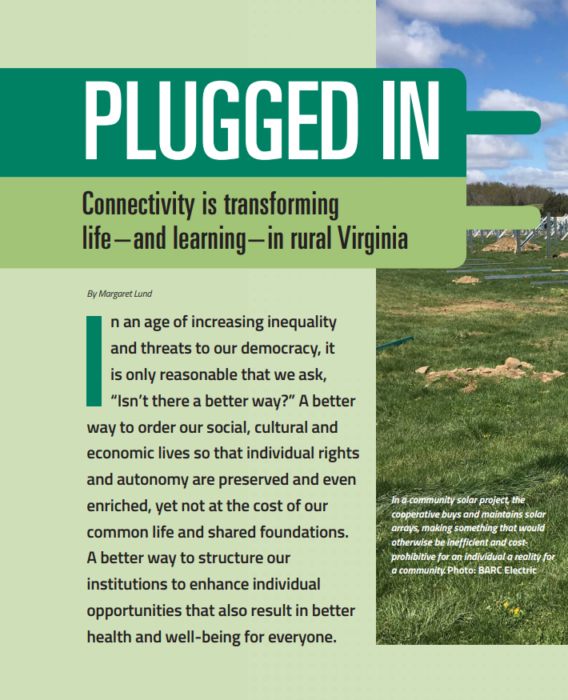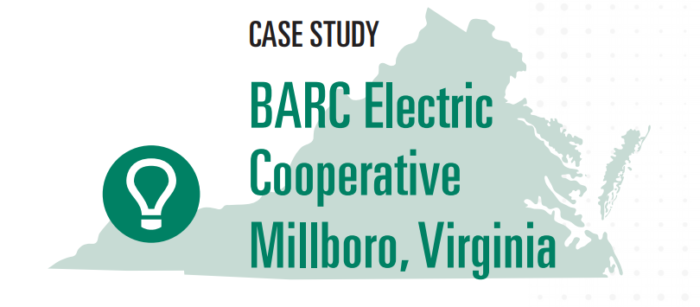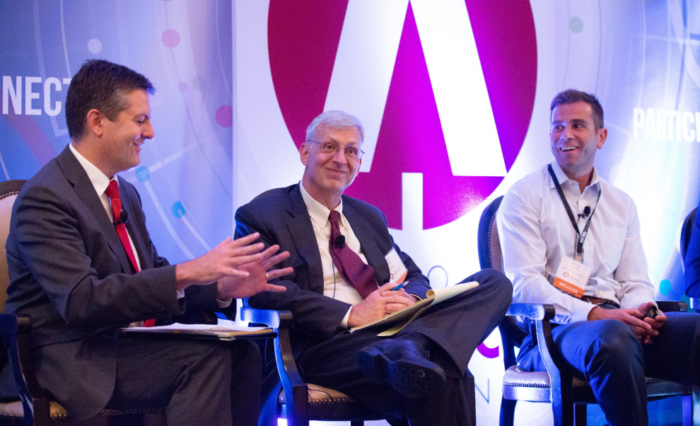
Spring 2019 – Room to Grow
Plugged In
Connectivity is transforming life–and learning–in rural Virginia
By Margaret Lund
In an age of increasing inequality and threats to our democracy, it is only reasonable that we ask, “Isn’t there a better way?” A better way to order our social, cultural and economic lives so that individual rights and autonomy are preserved and even enriched, yet not at the cost of our common life and shared foundations. A better way to structure our institutions to enhance individual opportunities that also result in better health and well-being for everyone.
Cooperatives are one of those ways. Owned and controlled by the people who benefit from them, co-ops exist on every continent, in virtually every country and across every industry. From daycare centers to funeral services, from small collectives to Fortune 500 businesses, co-ops exist to help ordinary people work together to meet their common economic, social and cultural needs and aspirations. In a co-op, this is done not for profit, but for the mutual benefit of the people affected. Co-ops are governed democratically, and all ascribe to a common set of values and principles including equity, equality, democracy, solidarity, self-help and self-responsibility.
Many businesses like to think of themselves as “good businesses” and “good neighbors,” and undoubtedly many of them are. Often, businesses will point to their charitable contributions or the number of jobs created as an indication of their value to the broader community. While important, these are not the types of impacts we will be considering in a new series of case studies designed to amplify “The ABCs of Co-op Impact,” a report published in the Winter 2019 issue of the Cooperative Business Journal.
Cooperatives in the U.S. have transformed entire industries, and have certainly changed lives in profound and meaningful ways.
To better understand co-ops and their link to healthy, equitable and sustainable communities, NCBA CLUSA and the Cooperative Development Foundation asked with the Urban Institute to develop a shared framework for assessing impact—on cooperative enterprises, their members and the communities they serve. This partnership was supported by a grant from the Robert Wood Johnson Foundation.
The resulting report outlines seven distinct ways in which cooperative enterprises differ from their investor-owned competitors, delivering superior social and economic benefits on the individual, firm and community level.
Cooperatives are not about charity given by donors; they are about service being provided by and for each other, about using the vehicle of self-help to change systems of distribution and wealth, addressing the root causes of marginalization—not just ameliorating its most distasteful effects. This is not to say that cooperative enterprises don’t also give generously to charity, or create a significant number of jobs. They do. But at the same time, their democratic structure and commitment to member benefit lead them to allocate resources, adopt timelines, articulate objectives and make decisions differently than either a profit-oriented firm or a nonprofit enterprise.
And these differences are not inconsequential. As we will see in the case studies that follow—in this issue, and in future issues of the Journal—cooperatives in the U.S. have transformed entire industries, and have certainly changed lives in profound and meaningful ways. Consumer and producer-owned cooperatives played a leading—and even defining—role in the development of the U.S. organic food industry, for example. And it is difficult not to appreciate the difference that electric power, broadband access, a secure home, a stable job or accessible and appropriate credit can make in the lives of an individual person.
In every sector, across every industry, we see important differences that cooperative enterprises make every day, generating opportunities and creating broadly beneficial community outcomes that are simply not being delivered to these same populations by similar institutions employing a conventional, investor-oriented approach. Democratic governance, for example, necessitates a level of transparency that is seldom seen in conventional corporations, large or small. Cooperatives are founded to address a market failure, right a wrong, or bring a level of fairness—even justice—to transactions that members believe is missing in the world around them.
For Mountain View Elementary School in rural Virginia, that missing piece was high-speed internet access. Then BARC Electric Cooperative stepped in.

Case Study: BARC Electric Cooperative Millboro, Virginia
BARC Electric was an early adopter of the cooperative model, incorporating in 1938, just three years after the Rural Electric Administration was formed. Eighty years later, they continue to be an innovator, bringing new services and opportunities to their membership.
The co-op provides service to 13,000 meters spread across five beautiful but sparsely populated counties in the Shenandoah Valley in rural western Virginia. Bringing access to electric service at a time when very few homes in the area had it was clearly the impetus behind the formation of BARC in the 1930s. Today, the co-op is actively engaged in meeting a new challenge for rural communities: bridging the digital divide.
Cooperatives are founded to address a market failure, right a wrong, or bring a level of fairness—even justice—to transactions that members believe is missing in the world around them.
Digital access—the easy availability of online content—is a profound 21st century measure of inequality between regions. Federal Communication Commission data indicate that 39 percent of rural Americans are not currently served by broadband service, compared with just 4 percent of city dwellers. Until recently, that 39 percent included nearly all of BARC’s members.
As in many rural counties, the co-op’s service area was experiencing a net out-migration of residents at the time BARC undertook its broadband effort; lack of access to reliable internet was clearly a factor. The local investor-owned telecommunications companies had not invested in network updates since they first installed DSL lines 20 years ago, and cell phone coverage continues to be spotty.
Not only do members have few reliable options for their own communications needs, but local businesses are equally affected. A vineyard in the area had long suffered from no internet or cell service in its tasting room, forcing the owners to drive to a coffee shop in a nearby town in order to conduct any online business. The local school system was paying thousands of dollars per month for just 3 megabits of internet at one of its elementary schools (a connection shared by hundreds of students and faculty).
BARC Electric itself needed more robust communications for its own business needs, especially at its 18 substations and delivery points, and co-op leaders soon realized that the problem was much bigger than themselves. Lack of access to broadband affected overall business sustainability in the region, and hampered educational achievement for area youth. As a utility, BARC Electric knew their business could only grow at the rate of business and household formation, so if these declined, so would the co-op.
While the challenge of financing, building and maintaining a whole new communications system was daunting for the small co-op, BARC leaders also realized their future depended on it. As CEO Mike Keyser put it, “It became apparent that this one is on us; no one else is going to do it.” Not only that, he added, but “it was our heritage, and it is our mission to serve the community in this way.” And so, the coop got busy.
In 2017, BARC Electric broke ground for the new broadband system, and in July 2018 the co-op linked up its largest customer to date, the Rockbridge County Public School District. Internet speed at Mountain View Elementary went from 3 mbps to 250 mbps overnight, at a fraction of the cost. Students and teachers now have access to high speed internet to support coursework, homework and research.

Not only that, but the school district can funnel its significant savings back into other educational needs. Two other school districts have now followed suit, joining BARC’s growing fiber network.
Broadband is different from electric service in that there is not a 100 percent take rate. It is a competitive field, and success is dependent upon engaging a sufficient segment of the community in the project. BARC’s prioritization of bringing service to school buildings and other community assets demonstrated the civic sense of mission in the way they approached broadband implementation. While an investor-owned utility “needs” to make its money back in a span of 3-4 years, a community-owned enterprise like BARC can take a longer view, financing capital costs over 20 years or more. For the cooperative, the broadband business—like their electric operations—is not about profit but about service to the community. The more service that can be had from the system at a price that is sustainable, the better for everyone in the community. As Keyser put it, “We are all in this together. The more people who support the project by participating, the quicker we can expand the network to serve everyone.”
BARC Electric takes a similar approach to its solar power initiatives, another area where this small cooperative leads the industry. Community solar “is a great co-op thing,” Keyser said, because it is hard and inefficient to do individually, but very efficient and a great service to members to do together. Instead of having to buy and maintain solar arrays individually, in a community solar project this is handled by the co-op. Rates are fixed for 20 years to cover both the initial costs of installing the system and the ongoing maintenance costs, and members get to enjoy a portion of their power from the centralized solar array.
Lack of access to broadband affected overall business sustainability in the region, and hampered educational achievement for area youth.
As with broadband, when BARC rolled out its community solar project in 2016, BARC’s staff made an extra effort to engage with schools. Its partnership with the Bath County School District culminated in the largest school solar power project in the state, and solar now supplies over 50 percent of the school system’s power needs. One of the schools in the area is totally supplied by solar—the only net-zero school building in Virginia. School leaders link lessons about their unique “micro-grid” to the school’s STEM curriculum, and students get a front seat lesson about how institutions that are committed to democratic governance and empowerment can change the world. “I was recently at a school board meeting where a student spoke about the pride they feel that their school district is a leader in solar energy,” Keyser said. “It made me realize these students are receiving something profound from this project beyond just the dollars and cents.”
For the cooperative, the broadband business — like their electric operations — is not about profit but about service to the community.
An important element of the Bath County schools solar project that is not apparent on the surface is the way that BARC Electric structured the system to best serve the community over the short and long term. Instead of just signing them up as a customer, BARC helped the school district to finance, build and maintain its own solar array. This means that when the 20-year capital costs have been paid, the district will likely have another 15 years of electric service from the array at minimal cost before the panels will have to be replaced. The net effect of this financing structure is the equivalent of an enormous financial contribution to public education in this rural region without having to raise a dollar of additional taxes. BARC leaders and its members understand that quality education is vital to equity, inclusion and prosperity for rural residents, and they act accordingly.
BARC’s new broadband subsidiary has already created over half a dozen new jobs, and this — together with the solar work — has gotten co-op employees excited and engaged about being involved in a company doing such important and impactful work. It is clear their co-op both supports the financial security of their workers and runs a sustainable business, and does so in a way that contributes directly to the growth of the region overall.
Looking for innovative new ways to contribute to the local economy and serve the membership is a collaborative endeavor at BARC, involving staff and management as well as the elected community board. In fact, strategic thinking is so important at BARC that the board members and management team commit to four strategic planning meetings a year (in some similar organizations, it’s hard to get the board to participate in just one!). BARC’s leaders use this important time together to reimagine the job of the cooperative not simply as a vehicle for supplying electricity, but as an enterprise leveraging knowledge and relationships toward the greater objective of improving the quality of life in the community. With a cooperative like that, BARC’s members can be assured of a strong and savvy ally in their corner to help meet the challenges that the decades ahead bring.
Margaret Lund is an independent consultant specializing in the areas of economic development financing and shared ownership strategies. Prior to launching her consulting firm in 2008, Margaret spent 16 years as executive director of a Community Development Financial Institution (CDFI), lending to co-ops across all sectors with an emphasis on food co-ops and other enterprises in the sustainable food sector.





